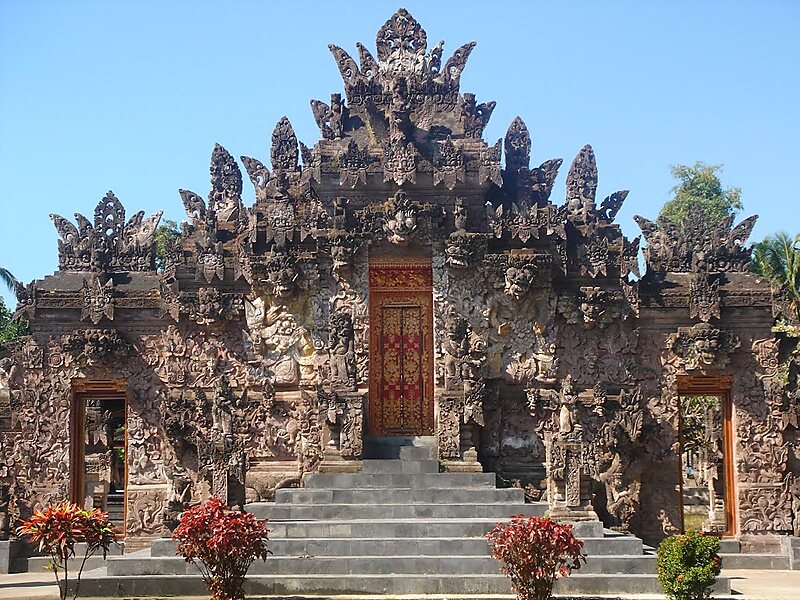Beji Temple: Architecture And Significance
Share
Nestled in the lush landscapes of Bali, Indonesia, Beji Temple, or Pura Beji, stands as a remarkable testament to the island's rich cultural heritage and architectural prowess. This temple, dedicated to the goddess of rice and fertility, Dewi Sri, is not just a place of worship but also a symbol of the Balinese people's deep connection to agriculture and spirituality.
Historical Background of Beji Temple
Beji Temple is believed to date back to the 15th century, during the reign of the Gelgel dynasty. Its establishment was primarily to honor Dewi Sri, the goddess who is integral to the agricultural practices of the Balinese people. The temple is located in the village of Sangsit, near Singaraja, and serves as a vital site for local ceremonies, particularly those related to rice cultivation.
Architectural Features of Beji Temple
Unique Design Elements
The architecture of Beji Temple is a stunning representation of Balinese temple design, characterized by intricate carvings, vibrant colors, and a harmonious blend with the surrounding nature. The temple complex features several shrines, each adorned with detailed sculptures that depict various deities and mythological figures.
The Main Shrine
The main shrine, known as "pelinggih," is dedicated to Dewi Sri and is surrounded by lush gardens and water features, symbolizing fertility and abundance. The shrine's architecture showcases the traditional Balinese style, with tiered roofs and ornate stone carvings that narrate stories from Hindu mythology.
Symbolism in Architecture
Every element of Beji Temple's architecture holds significance. The use of water, for instance, is a vital aspect of the temple's design, representing purification and the life-giving properties of rice. The temple's layout is meticulously planned to align with the cardinal directions, reflecting the Balinese belief in harmony between the cosmos and earthly existence.
Cultural Significance of Beji Temple
A Hub for Agricultural Rituals
Beji Temple plays a crucial role in the agricultural calendar of Bali. It is the site of various ceremonies that celebrate the rice harvest, including the "Ngusaba" festival, where offerings are made to Dewi Sri to ensure a bountiful harvest. These rituals not only honor the goddess but also reinforce the community's connection to the land.
Preservation of Balinese Traditions
The temple serves as a living museum of Balinese culture, where traditional practices and rituals are preserved and passed down through generations. Visitors to Beji Temple can witness the vibrant ceremonies that take place throughout the year, providing a unique insight into the spiritual life of the Balinese people.
A Place of Pilgrimage
For many Balinese, Beji Temple is a sacred site that attracts pilgrims seeking blessings for fertility and prosperity. The temple's significance extends beyond its architectural beauty; it is a place where the community gathers to celebrate their shared beliefs and cultural identity.
Visiting Beji Temple
Best Time to Visit
The ideal time to visit Beji Temple is during the dry season, which runs from April to October. During these months, the weather is pleasant, making it easier to explore the temple grounds and participate in local ceremonies.
What to Expect
Visitors can expect to be greeted by stunning landscapes, intricate temple architecture, and a serene atmosphere. It is advisable to dress modestly and respectfully, as Beji Temple is a sacred site. Engaging with local guides can enhance your experience, providing deeper insights into the temple's history and significance.
Nearby Attractions
While in the area, consider exploring other nearby attractions such as:
- Sangsit Beach: A tranquil beach perfect for relaxation and enjoying the sunset.
- Pura Meduwe Karang: Another significant temple nearby, known for its unique architecture.
- Local Rice Fields: Take a stroll through the picturesque rice paddies that surround the area.
Conclusion
Beji Temple is more than just an architectural marvel; it embodies the spiritual and agricultural essence of Bali. Its intricate designs and rich cultural significance make it a must-visit destination for anyone looking to understand the heart of Balinese traditions. Whether you're drawn to its beauty, its rituals, or its historical importance, Beji Temple offers a unique glimpse into the soul of Bali.
For those planning a visit, consider booking your accommodations and flights through the following links to ensure a smooth and enjoyable trip:
Experience the magic of Beji Temple and immerse yourself in the vibrant culture of Bali!




